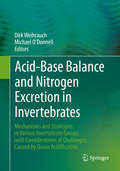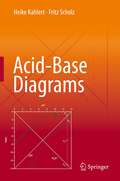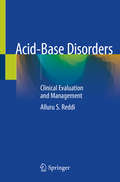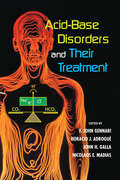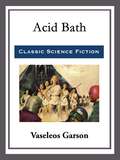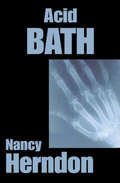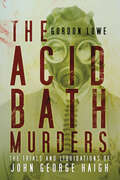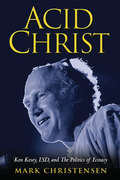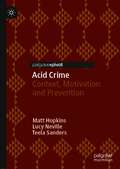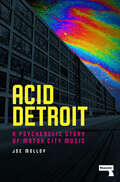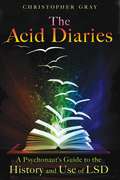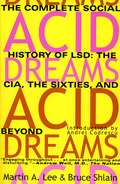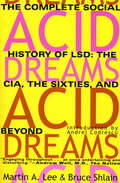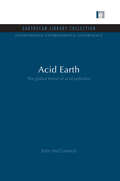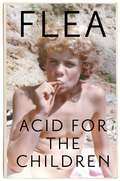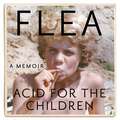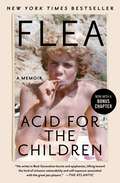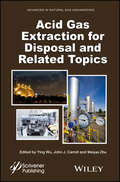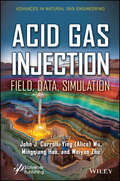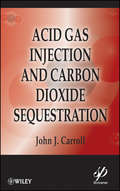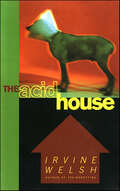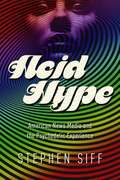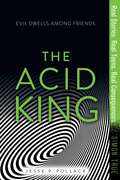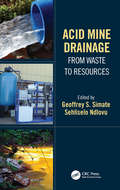- Table View
- List View
Acid-Base and Electrolyte Handbook for Veterinary Technicians
by David Liss Angela Randels-ThorpAcid-Base and Electrolyte Handbook for Veterinary Technicians provides an easy to understand yet comprehensive approach to acid-base and electrolyte balance. Covers the physiology of fluids and their effect on acid-base and electrolyte balance Offers detailed information on managing acid-base and electrolyte derangements in disease Includes access to a companion website with case studies and multiple choice questions
Acid-Base Balance and Nitrogen Excretion in Invertebrates: Mechanisms and Strategies in Various Invertebrate Groups with Considerations of Challenges Caused by Ocean Acidification
by Dirk Weihrauch Michael O’donnellThis textbook provides a comprehensive overview on the diverse strategies invertebrate animals have developed for nitrogen excretion and maintenance of acid-base balance and summarizes the most recent findings in the field, obtained by state-of-the-art methodology. A broad range of terrestrial, freshwater and marine invertebrate groups are covered, including crustaceans, cephalopods, insects and worms. In addition the impact of current and future changes in ocean acidification on marine invertebrates due to anthropogenic CO2 release will be analyzed. The book addresses graduate students and young researchers interested in general animal physiology, comparative physiology and marine/aquatic animal physiology. Also it is an essential source for researchers dealing with the effects of increasing pCO2 levels on aquatic animals, of which the vast majority are indeed invertebrates. All chapters are peer-reviewed.
Acid-Base Diagrams
by Heike Kahlert Fritz ScholzUnderstanding acid-base equilibria made easy for students in chemistry, biochemistry, biology, environmental and earth sciences. Solving chemical problems, be it in education or in real life, often requires the understanding of the acid-base equilibria behind them. Based on many years of teaching experience, Heike Kahlert and Fritz Scholz present a powerful tool to meet such challenges. They provide a simple guide to the fundamentals and applications of acid-base diagrams, avoiding complex mathematics. This textbook is richly illustrated and has full color throughout. It offers learning features such as boxed results and a collection of formulae.
Acid-Base Disorders: Clinical Evaluation and Management
by Alluru S. ReddiThis book provides a concise yet comprehensive overview of acid-base disorders. Each chapter reviews an acid-base disorder, covering pathophysiology, evaluation, and management of the disorder. The chapters also include clinical cases and a Q&A section, based on scenarios and questions that clinicians regularly encounter when treating patients with these disorders. The book concludes with two chapters on acid-based disorders in special patient populations, including critically ill patients, pregnant patients, and surgical patients. Written by an expert in the field, Acid-Base Disorders: Clinical Evaluation and Management is a state-of-the-art resource that should assist clinicians and practitioners in managing patients with acid-base disorders.
Acid-Base Disorders and Their Treatment
by F. John GennariWith detailed contributions and research from experts in the physiology of normal acid-base homeostasis and the management of acid-base disorders, this reference supplies an abundance of information on acid-base physiology, disorders of acid-base equilibrium, and the management and treatment of these disorders in clinical practice. A unique and tim
Acid Bath
by Vaseleos GarsonThe starways' Lone Watcher had expected some odd developments in his singular, nerve-fraught job on the asteroid. But nothing like the weird twenty-one-day liquid test devised by the invading Steel-Blues.
Acid Bath (Elena Jarvis Ser.)
by Nancy HerndonElena Jarvis is an officer committed to her duty at the Los Santos, Texas, Department of Crimes Against Persons. Not that anyone is helping her there, not when her ex-husband is in the next room, her boss treats her like a little girl and her partner thinks women shouldn't leave the kitchen. Elena always knew there would be obstacles in her job; she just figured they would come from the criminals. When an erotic poet accuses his ex-wife, Sarah, of trying to murder him with an exploding escargot, Elena has doubts of the reality of the crime. But the more she learns about their nasty divorce, the more she begins to side with Sarah, until she finds the poet's body decaying in a bathtub filled with more than just water. Before the acid eats away all the evidence, Elena must put aside her sympathies for the victimized ex-wife and get down to the bare bones of this murder before someone else becomes the next victim.
The Acid Bath Murders: The Trials and Liquidations of John George Haigh
by Gordon LoweJohn George Haigh committed five perfect murders – by dissolving his wealthy victims in sulphuric acid. Then he tipped away the resultant soup to avoid detection on a ‘no body, no murder’ principle and used his victims’ property to fund his luxury lifestyle of silk ties and flashy cars. Murder number six was less than perfect. When a guest in Haigh’s hotel disappeared, the police found half-dissolved body parts carelessly thrown into the yard outside his secluded workshop. But was the urbane Mr Haigh, the man brought up by strict Plymouth Brethren parents in Yorkshire and dressed like a city stockbroker, really the monster he said he was? Did he really kill six innocent people just so he could drink their blood? Using unpublished archive papers, including recently released letters Haigh wrote from prison while awaiting execution, author Gordon Lowe sheds light on whether Haigh’s claims were a cynical ploy for a ticket into Broadmoor Hospital, or if he was a psychopathic vampire with a penchant for disposing of his victims in acid.
Acid Christ: Ken Kesey, LSD, and the Politics of Ecstasy
by Mark ChristensenFrom the literary wonder boy to the countercultural guru whose cross-country bus trip inspired The Electric Kool-Aid Acid Test, this candid biography chronicles the life and times of cultural icon Ken Kesey from the 1960s through the 1980s. Presenting an incisive analysis of the author who described himself as "too young to be a beatnik, and too old to be a hippie," this account conducts a mesmerizing journey from the perspective of Mark Christensen, an eventual member of the Kesey "flock." Featuring interviews with those within his inner circle, this exploration reveals the bestselling author of One Flew Over the Cuckoo's Nest in his many forms, placing him within the framework of his time, his generation, and the zeitgeist of the psychedelic era.
Acid Crime: Context, Motivation and Prevention (Palgrave Studies in Risk, Crime and Society)
by Matt Hopkins Lucy Neville Teela SandersThis book provides an authoritative overview of the contemporary phenomenon widely labelled as ‘acid attacks’. Although once thought of as a predominantly ‘gendered crime’, acid and other corrosive substances have been used in a range of violence crimes. This book explores the historical use of corrosives in crime, legal definitions of such attacks, the contexts in which corrosives are used, victim characteristics, offender motivations for carrying and decanting corrosives, and preventative strategies. Data is drawn from the international literature and the analysis of primary data collected in the UK (which is thought to have one of the highest rates of acid attacks in the world) from interviews with over 20 convicted offenders and from police case files relating to over 1,000 crimes involving corrosive substances. This book adds significantly to the international literature on weapons carrying and use, which to date has predominantly focused around the possession and use of guns and knives.
Acid Detroit: A Psychedelic Story of Motor City Music
by Joe MolloyAcid Detroit tells the story of Motor City through its revolutionary music past and present, in order to find the seeds of radical transformation among its ruins.Acid Detroit is an exhilarating, technicolour view of Detroit&’s musical and social history from the 1960s to the present day. Redefining the counterculture as a time of Acid Communism, Acid Detroit diverges from most books on the Sixties, which centre on California, to show that Detroit was an unequalled hotbed of radical activism, urban unrest and sonic innovation. Considering Detroit's unique mix of people and cultures and enduring sonic legacies, it covers everything from incendiary garage rock, to European-influenced techno and experimental hip-hop crews, intertwining the artist&’s lives and works with the city&’s rise and decline, from its establishment as an industrial powerhouse to the high point of Motor City, into its decline and tentative rebirth. A mind-expanding tour through time and space that explores the lost possibilities, histories and hidden potentials of the city, Acid Detroit reveals a history of resilience and transformation hidden in the shadows of the abandoned factories and warehouses of the Motor City.
The Acid Diaries: A Psychonaut’s Guide to the History and Use of LSD
by Christopher GrayAn exploration of the personal and spiritual truths revealed through LSD • Reveals that LSD visions weave an ongoing story from trip to trip • Shows that trips progress through three stages: personal issues and pre-birth consciousness, ego-loss, and on to the sacred • Explores psychedelic use throughout history, including the mass hallucinations common in the Middle Ages and the early therapeutic use of LSD Toward the end of his fifties, Christopher Gray took, for the first time in years, a 100-microgram acid trip. So extraordinary, and to his surprise so enjoyable, were the effects that he began to take the same dose in the same way--quietly and on his own--once every two to three weeks. In The Acid Diaries, Gray details his experimentation with LSD over a period of three years and shares the startling realization that his visions were weaving an ongoing story from trip to trip, revealing an underlying reality of personal and spiritual truths. Following the theories of Stanislav Grof and offering quotes from others’ experiences that parallel his own--including those of Aldous Huxley, Albert Hofmann, and Gordon Wasson--he shows that trips progress through three stages: the first dealing with personal issues and pre-birth consciousness; the second with ego-loss, often with supernatural overtones; and the third with sacred, spiritual, and even apocalyptic themes. Pairing his experiences with an exploration of psychedelic use throughout history, including the ergot-spawned mass hallucinations that were common through the Middle Ages and the early use of LSD for therapeutic purposes, Gray offers readers a greater understanding and appreciation for the potential value of LSD not merely for transpersonal growth but also for spiritual development.
Acid Dreams: The CIA, the Sixties, and Beyond
by Martin A. Lee Bruce ShlainMartin Lee and Bruce Shlain's exhaustively researched and astonishing account -- part of it gleaned from secret government files -- tells how the CIA became obsessed with LSD as an espionage weapon during the early l950s and launched a massive covert research program, in which countless unwitting citizens were used as guinea pigs. Though the CIA was intent on keeping the drug to itself, it ultimately couldn't prevent it from spreading into the popular culture; here LSD had a profound impact and helped spawn a political and social upheaval that changed the face of America.
Acid Dreams: The Complete Social History of LSD: The CIA, the Sixties, and Beyond
by Martin A. Lee Bruce Shlain“An engrossing account” of the history of LSD, the psychedelic 1960s, and the clandestine mind games of the CIA (William Burroughs). Beginning with the discovery of LSD in 1943, this “monumental social history of psychedelia” tracks the most potent drug known to science—from its use by the government during the paranoia of the Cold War to its spill-over into a revolutionary antiestablishment recreation during the Vietnam War—setting the stage for one of the great ideological battles of the decade (The Village Voice). In the intervening years, the CIA launched a massive covert research program in the hope that LSD would serve as an espionage weapon; psychiatric pioneers came to believe that acid would shed light on the perplexing problems of mental illness; and a new generation of writers and artists in countercultural transition sought to break the “mind-forged manacles” of a new generation in rebellion—among them, Timothy Leary, Ken Kesey, the Beatles, Allen Ginsberg, William Mellon Hitchcock, and Abbie Hoffman. Painting an indelible portrait of an unforgettable era and using startling information obtained through the Freedom of Information Act, Acid Dreams also exposes one of the most bizarre, shocking, and often tragic episodes in American history. “An important historical synthesis of the spread and effects of a drug that served as a central metaphor for an era.” —John Sayles “Marvelously detailed . . . loaded with startling revelations.” —Los Angeles Daily News
Acid Earth: The Global Threat of Acid Pollution (International Environmental Governance Set)
by John McCormickAcid rain was one of the major environmental issues of the 1980s. But while industrialized countries have taken measures to reduce the emissions that lead to acidification, the problems have not gone away. Trees are still dying, lakes are still being made uninhabitable; buildings are still corroding; and human health is still suffering. The most worrying trend is the repetition in the industrializing countries of Asia and Latin America of the problems that have long afflicted Europe and North America. More than 10 years after it was first published, the highly acclaimed Acid Earth still provides the only global view of acidification, and remains the standard text on the subject. Chapters on the causes, effects and growing scientific understanding of acid pollution, and the possible solutions, are followed by detailed studies of the political struggles involved in responding to acid damage in western and eastern Europe, the US and the newly industrializing countries. Written in non-technical language for people interested in the problems of the environment, Acid Earth calls for a renewed sense of public and political will to bring the problems of acid pollution under control. The book also makes valuable reading for specialists and students. Originally published in 1992
Acid For The Children - The autobiography of Flea, the Red Hot Chili Peppers legend: A Memoir
by FleaFlea, the iconic bassist and co-founder, alongside Anthony Kiedis, of the immortal Red Hot Chili Peppers finally tells his fascinating origin story, complete with all the dizzying highs and the gutter lows you'd expect from an LA street rat turned world-famous rock star.Michael Peter Balzary was born in Melbourne, Australia, on October 16, 1962. His more famous stage name, Flea, and his wild ride as the renowned bass player for the Red Hot Chili Peppers was in a far and distant future. Little Michael from Oz moved with his very conservative, very normal family to Westchester, New York, where life as he knew it was soon turned upside down. His parents split up and he and his sister moved into the home of his mother's free-wheeling, jazz musician boyfriend - trading in rules, stability, and barbecues for bohemian values, wildness, and Sunday afternoon jazz parties where booze, weed, and music flowed in equal measure. There began Michael's life-long journey to channel all the frustration, loneliness, love, and joy he felt into incredible rhythm.When Michael's family moved to Los Angeles in 1972, his home situation was rockier than ever. He sought out a sense of belonging elsewhere, spending most of his days partying, playing basketball, and committing petty crimes. At Fairfax High School, he met another social outcast, Anthony Kiedis, who quickly became his soul brother, the yin to his yang, his partner in mischief. Michael joined some bands, fell in love with performing, and honed his skills. But it wasn't until the night when Anthony, excited after catching a Grandmaster Flash concert, suggested they start their own band that he is handed the magic key to the cosmic kingdom.Acid for the Children is as raw, entertaining and wildly unpredictable as its author. It's both a tenderly evocative coming of age story and a raucous love letter to the power of music and creativity
Acid For The Children - The autobiography of Flea, the Red Hot Chili Peppers legend
by FleaThe strange tale of a boy named Flea starts in Rye, NY. It was all very normal. But soon his parents divorced and his mother Patricia remarried a jazz musician. Flea's stepfather frequently invited musicians to his house for jam sessions which sparked Flea's interest in music. The family moved to Los Angeles, where Flea became fascinated with the trumpet, idolizing musicians like Miles, Dizzy, and Louis.But the family soon fell apart, "I was raised in a very violent, alcoholic household," Flea later said. "I grew up being terrified of my parents, particularly my father figures. It caused [me] a lot of trouble later in life." He began smoking weed at 13, and became a daily user of harder drugs. He was on the streets by 14 and soon after, met another social outcast and drug user named Anthony Kiedis. They form a band that would become the Red Hot Chili Peppers.ACID FOR THE CHILDREN is pure, uncut Flea, with nothing left unsaid.(P)2018 Hachette Audio
Acid for the Children: A Memoir
by FleaThe iconic bassist and co-founder of the Red Hot Chili Peppers tells his fascinating origin story, complete with all the dizzying highs and the gutter lows you'd want from an LA street rat turned world famous rock star. <P><P>In Acid for the Children, Flea takes readers on a deeply personal and revealing tour of his formative years, spanning from Australia to the New York City suburbs to, finally, Los Angeles. Through hilarious anecdotes, poetical meditations, and occasional flights of fantasy, Flea deftly chronicles the experiences that forged him as an artist, a musician, and a young man. His dreamy, jazz-inflected prose makes the Los Angeles of the 1970s and 80s come to gritty, glorious life, including the potential for fun, danger, mayhem, or inspiration that lurked around every corner. <P><P>It is here that young Flea, looking to escape a turbulent home, found family in a community of musicians, artists, and junkies who also lived on the fringe. He spent most of his time partying and committing petty crimes. But it was in music where he found a higher meaning, a place to channel his frustration, loneliness, and love. This left him open to the life-changing moment when he and his best friends, soul brothers, and partners-in-mischief came up with the idea to start their own band, which became the Red Hot Chili Peppers. <P><P>Acid for the Children is the debut of a stunning new literary voice, whose prose is as witty, entertaining, and wildly unpredictable as the author himself. It's a tenderly evocative coming-of-age story and a raucous love letter to the power of music and creativity from one of the most renowned musicians of our time. <P><P><b>A New York Times Bestseller</b>
Acid Gas Extraction for Disposal and Related Topics
by Ying Wu John J. Carroll Weiyao ZhuThis is the fifth volume in a series of books focusing on natural gas engineering, focusing on the extraction and disposal of acid gas. This volume includes information for both upstream and downstream operations, including chapters on modeling, carbon capture, chemical and thermodynamic models, and much more. Written by some of the most well-known and respected chemical and process engineers working with natural gas today, the chapters in this important volume represent the most cutting-edge and state-of-the-art processes and operations being used in the field. Not available anywhere else, this volume is a must-have for any chemical engineer, chemist, or process engineer working with natural gas. There are updates of new technologies in other related areas of natural gas, in addition to the extraction and disposal of acid gas, including testing, reservoir simulations, acid gas injection, and natural gas hydrate formations. Advances in Natural Gas Engineering is an ongoing series of books meant to form the basis for the working library of any engineer working in natural gas today. Every volume is a must-have for any engineer or library.
Acid Gas Injection: Field, Data, Simulation
by John J. Carroll Ying Alice Wu Mingqiang Hao Weiyao ZhuThis ninth and final volume in the series, Advances in Natural Gas Engineering, covers gas injection into geological formations, one of the hottest topics in the industry, with contributions from some of the most well-known and respected engineers in the world. This timely book focuses on gas injection into geological formations and other related topics, which are very important areas of natural gas engineering and build on previous volumes. It includes information for both upstream and downstream operations, including chapters detailing the most cutting-edge techniques in acid gas injection, such as acid gas disposal, modeling, and much more. Written by some of the most well-known and respected chemical and process engineers working with natural gas today, the chapters in this important volume represent the most state-of-the-art processes and operations used in the field. Not available anywhere else, this volume is a must-have for any chemical engineer, chemist, or process engineer in the industry. Advances in Natural Gas Engineering is a series of books meant to form the basis for the working library of any engineer working with natural gas today.
Acid Gas Injection and Carbon Dioxide Sequestration
by John J. CarrollProvides a complete treatment on two of the hottest topics in the energy sector - acid gas injection and carbon dioxide sequestration This book provides the most comprehensive and up-to-date coverage of two techniques that are rapidly increasing in importance and usage in the natural gas and petroleum industry - acid gas injection and carbon dioxide sequestration. The author, a well-known and respected authority on both processes, presents the theory of the technology, then discusses practical applications the engineer working in the field can implement. Both hot-button issues in the industry, these processes will help companies in the energy industry "go green," by creating a safer, cleaner environment. These techniques also create a more efficient and profitable process in the plant, cutting waste and making operations more streamlined. This outstanding new reference includes: Uses of acid gas injection, the method of choice for disposing of small quantities of acid gas Coverage of technologies for working towards a zero-emission process in natural gas production A practical discussion of carbon dioxide sequestration, an emerging new topic, often described as one of the possible solutions for reversing global warming Problems and solutions for students at the graduate level and industry course participants
The Acid House (Jonathan Cape Originals Ser.)
by Irvine WelshIrvine Welsh's scintillating, disturbing, and altogether outrageous collection of stories—the basis for the 1998 cult movie directed by Paul McGuigan. He is called "the Scottish Celine of the 1990s" (Guardian) and "a mad, postmodern Roald Dahl" (Weekend Scotsman). Using a range of approaches from bitter realism to demented fantasy, Irvine Welsh is able to evoke the essential humanity, well hidden as it is, of his generally depraved, lazy, manipulative, and vicious characters. He specializes particularly in cosmic reversals—God turn a hapless footballer into a fly; an acid head and a newborn infant exchange consciousnesses with sardonically unexpected results—always displaying a corrosive wit and a telling accuracy of language and detail. Irvine Welsh is one hilariously dangerous writer who always creates a sensation.
Acid Hype: American News Media and the Psychedelic Experience
by Stephen SiffNow synonymous with Sixties counterculture, LSD actually entered the American consciousness via the mainstream. Time and Life, messengers of lumpen-American respectability, trumpeted its grand arrival in a postwar landscape scoured of alluring descriptions of drug use while outlets across the media landscape piggybacked on their coverage with stories by turns sensationalized and glowing. Acid Hype offers the untold tale of LSD's wild journey from Brylcreem and Ivory soap to incense and peppermints. As Stephen Siff shows, the early attention lavished on the drug by the news media glorified its use in treatments for mental illness but also its status as a mystical--yet legitimate--gateway to exploring the unconscious mind. Siff's history takes readers to the center of how popular media hyped psychedelic drugs in a constantly shifting legal and social environment, producing an intricate relationship between drugs and media experience that came to define contemporary pop culture. It also traces how the breathless coverage of LSD gave way to a textbook moral panic, transforming yesterday's refined seeker of truths into an acid casualty splayed out beyond the fringe of polite society.
The Acid King (Simon True)
by Jesse P. PollackReal stories. Real teens. Real consequences. A murder in a small Long Island town reveals the dark secrets lurking behind the seemingly peaceful façade in this latest installment of the Simon True series.On June 19, 1984, seventeen-year-old Ricky Kasso murdered Gary Lauwers in what local police and the international press dubbed a &“Satanic Sacrifice.&” The murder became the subject of several popular songs, and television specials addressed the issue of whether or not America&’s teens were practicing Satanism. Even Congress got in on the act, debating Satanic symbolism in songs by performers like AC/DC and Ozzy Osbourne. &“The country is in crisis!&” screamed the pundits. After all, it was the height of the Reagan era and Nancy Reagan&’s &“just say no&” campaign was everywhere. But what this case revealed were bigger problems lurking at the heart of suburban America. Ricky Kasso wasn&’t a bad kid, but he was lost. To feel better, he started smoking pot, moving on from that to PCP and LSD. He ended up living on the streets and thinking he had nothing to lose. Gary Lauwers went from being a victim of bullying to using drugs to fit in, and finally robbery—but then he made the mistake of stealing from Ricky, and from that moment on, his fate was sealed. A few months later, Gary went into the woods behind the park with Ricky and two other boys. Only three of them came out. The subsequent police investigation and accompanying media circus turned the village upside down. It shattered the image of an idyllic small town, changed the way neighbors viewed each other, and recast the War on Drugs.
Acid Mine Drainage: From Waste to Resources
by Geoffrey S. Simate Sehliselo NdlovuAcid mine drainage (AMD) is essentially the flow of water polluted with metals and other substances from existing/old mining areas and is considered to be one of the sources of pollution. A wide range of technologies are available for preventing AMD generation and/or treating AMD before discharge, but there is a shift towards recovery of industrially useful materials and products from AMD. Acid Mine Drainage: From Waste to Resources explores novel methods developed for the reuse and/or recovery of industrially useful materials from AMD including discussing generation, prediction, prevention, and remediation processes. It includes legislation and policy frameworks governing AMD and its environmental/health impacts. Provides a detailed overview of the mining operations and discusses the geochemical and hydrogeological context of acid mine drainage AMD formation, prediction and impact Presents a holistic approach to AMD generation, prediction, prevention, and remediation processes Presents exclusive material on reuse, recycling, and recovery of industrially useful materials from AMD Gives a detailed overview of the legislation and policy regulatory framework governing the management of AMD Analyses the effects of AMD on the environment and health This volume is aimed at researchers and professionals in metallurgical engineering, chemical engineering, environmental engineering, and mining engineering, including policy makers.

